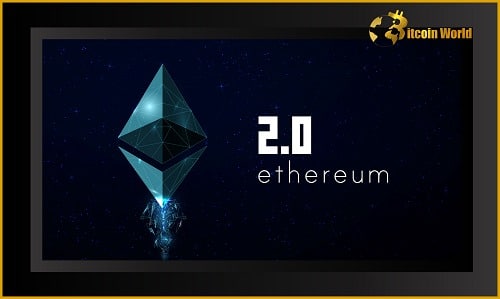Ethereum, the world’s second-largest cryptocurrency, is undergoing a significant transformation with its shift to Ethereum 2.0. While the original proof-of-work (PoW) Ethereum chain continues to operate robustly, evidenced by its hashrate reaching impressive new peaks this year, the highly anticipated transition to a proof-of-stake (PoS) consensus mechanism is steadily progressing. A key component of this evolution is the ETH 2.0 contract, a digital vault where ether (ETH) is locked up to fuel the new PoS network. Let’s dive into the fascinating world of ETH 2.0 and explore the immense value locked within this contract.
What is the ETH 2.0 Contract and Why Does it Matter?
Think of the ETH 2.0 contract as the engine room powering the Ethereum 2.0 upgrade. To participate in securing and validating transactions on the new PoS Ethereum network, users need to become validators. And to become a validator? You need to stake ETH. Specifically, 32 ETH is the magic number required to join the validator pool. This staked ETH is deposited into the ETH 2.0 contract, essentially locking it up for the purpose of network consensus and security.
This concept isn’t entirely new. Ethereum co-founder Vitalik Buterin himself contributed to this contract when it was initially launched back on November 6, 2020, signaling the project’s serious intent from the outset. But the scale of ETH locked now is truly staggering.
The Billions Locked: A Deep Dive into the ETH 2.0 Vault
Fast forward to January 17, 2022, and data from etherscan.io reveals some eye-popping figures. The ETH 2.0 contract now holds approximately 9,057,890 ETH! To put that into perspective, at current prices, this stash is valued at over $28 billion. Just the day before, on January 16, 2022, the contract crossed the 9 million ETH milestone. The growth is undeniable and reflects increasing confidence in Ethereum 2.0 and the future of staking.
Here’s a quick snapshot of the key figures:
| Metric | Value |
|---|---|
| ETH Locked in ETH 2.0 Contract (as of Jan 17, 2022) | ~9,057,890 ETH |
| Value of Locked ETH | Over $28 Billion |
| Milestone Reached | Exceeded 9 Million ETH on Jan 16, 2022 |
Ethereum Price Fluctuations: A Rollercoaster Ride?
While the long-term picture for Ethereum often looks bullish, the crypto market is known for its volatility. Year-to-date, Ethereum’s price has seen impressive gains, climbing over 150 percent. However, the recent short-term trend tells a different story. In the last 30 days, Ether’s price has decreased by around 18.5 percent. Zooming in further, two-week statistics show a value loss of 17.5 percent against the US dollar.
This price fluctuation needs to be viewed in the context of the broader cryptocurrency market, which can be influenced by various factors including regulatory news, macroeconomic trends, and overall market sentiment. Despite these short-term dips, the fundamental developments within the Ethereum ecosystem, such as the ETH 2.0 upgrade, remain significant drivers of long-term value.
Market Dominance: Where Does Ethereum Stand?
Ethereum’s market capitalization dominance, a measure of its value relative to the entire cryptocurrency market, provides another perspective. In 2021, Ethereum enjoyed a market cap dominance ranging from 18-20%. Currently, that figure sits at approximately 17.9%. While a slight decrease, it still signifies Ethereum’s strong position as a leading cryptocurrency. Market dominance is a dynamic metric, constantly shifting with market trends and the performance of other cryptocurrencies, including emerging altcoins.
EIP-1559 and the Burning Mechanism: Adding Another Layer of Value
Beyond the ETH locked in the ETH 2.0 contract, there’s another crucial aspect contributing to Ethereum’s value proposition: the burning of ETH through EIP-1559. Since the implementation of EIP-1559, a mechanism that burns a portion of the ETH used for transaction fees, a significant amount of Ether has been permanently removed from circulation.
As of the latest data, a staggering 1,541,113 ETH, worth around $5.8 billion, has been burned since EIP-1559 went live. This burning mechanism is designed to make ETH a deflationary asset over time, potentially increasing its scarcity and value.
The Combined Power: ETH 2.0 Contract and Burned ETH
When we combine the value locked in the ETH 2.0 contract with the value of ETH burned through EIP-1559, the total figure is truly remarkable. At the time of writing, this combined value amounts to a massive $33.8 billion. This represents a significant commitment to the Ethereum network and its future, showcasing the immense economic activity and value accumulation within the ecosystem.
Let’s break down the combined value:
- Value of ETH in ETH 2.0 Contract: ~$28 Billion
- Value of Burned ETH (EIP-1559): ~$5.8 Billion
- Total Combined Value: ~$33.8 Billion
This substantial figure underscores the scale of investment and belief in the Ethereum network. It highlights the economic engine driving the transition to Ethereum 2.0 and the potential for long-term growth and value appreciation.
Related Reads: – Ex-SEC Chair, Jay Clayton Believes Cryptocurrency Industry Is For Long Haul
In Conclusion: Ethereum 2.0 – A Future Secured?
The sheer volume of ETH locked in the ETH 2.0 contract, coupled with the ongoing burning of ETH through EIP-1559, paints a compelling picture of the Ethereum ecosystem. While short-term price fluctuations are inherent in the crypto market, the fundamental strength and long-term vision of Ethereum 2.0 are undeniable. The billions of dollars locked and burned represent a powerful testament to the community’s belief in Ethereum’s future and its potential to revolutionize the digital landscape. As Ethereum continues its journey towards a more scalable, secure, and sustainable future with ETH 2.0, the world will be watching closely.
Disclaimer: The information provided is not trading advice, Bitcoinworld.co.in holds no liability for any investments made based on the information provided on this page. We strongly recommend independent research and/or consultation with a qualified professional before making any investment decisions.


